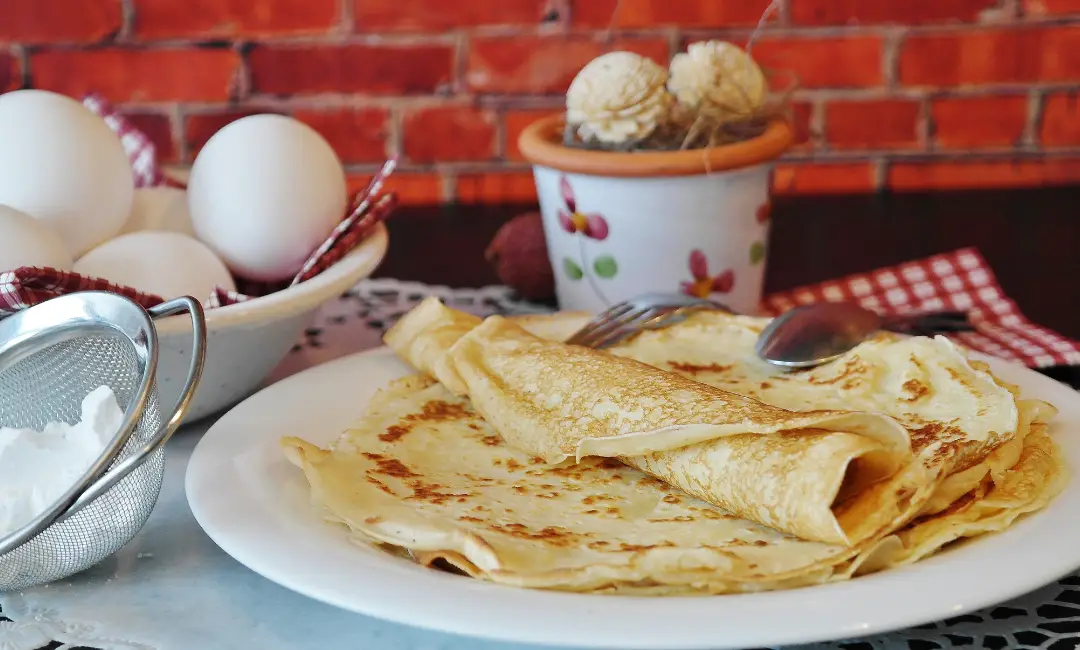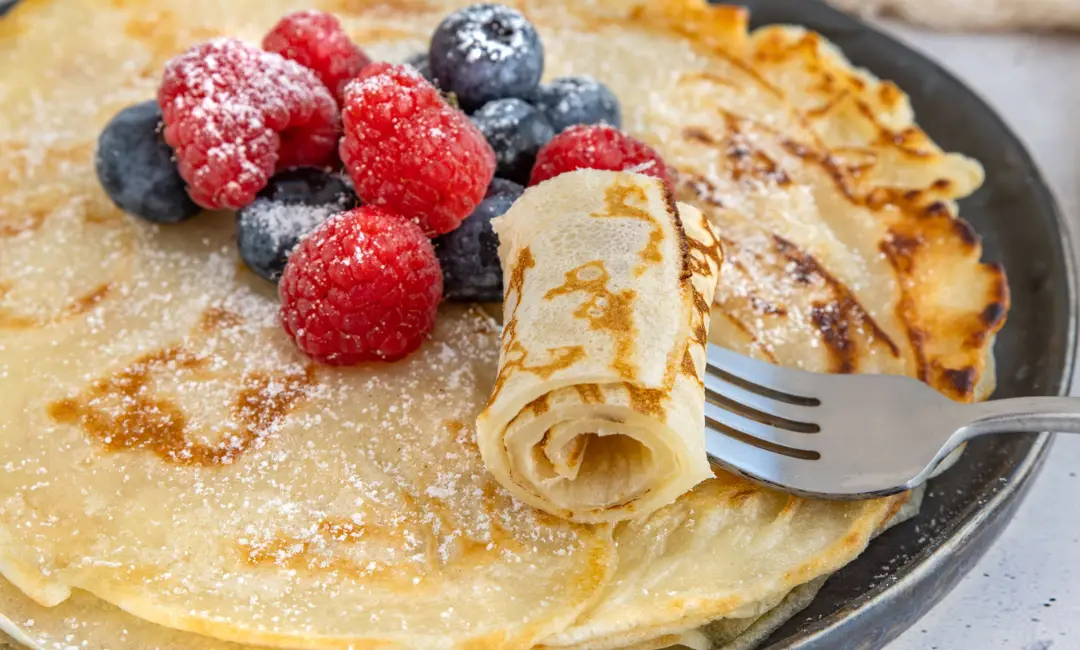Why Homemade Crêpes?
Welcome to the delightful world of homemade crêpes! Whether you’re looking to whip up a quick breakfast, a sophisticated dessert, or a savory meal, crêpes are the perfect canvas. Making crêpes at home might seem intimidating at first, but with a few simple techniques and some practice, you’ll be flipping them like a pro in no time. Plus, the beauty of homemade crêpes lies in their versatility and the joy of customizing them with your favorite fillings.
There’s something incredibly satisfying about making crêpes from scratch. Firstly, the ingredients are basic pantry staples, making it an easy decision for a last-minute meal or dessert. Secondly, homemade crêpes allow for complete control over the thickness and size, ensuring they’re exactly to your liking. Moreover, preparing crêpes at home creates a wonderful opportunity for family cooking fun, allowing everyone to get involved in the flipping and filling. Lastly, homemade crêpes are a blank slate for creativity, enabling you to experiment with various fillings and presentations that cater to all tastes and dietary preferences.
The history and origins of crêpes
The history and origins of crêpes trace back to Brittany, a region in the northwest of France, where they are considered a national dish. This delicate pancake has evolved over centuries and has a rich history that reflects the culinary traditions of France.
Origins
Crêpes date back to the 13th century in Brittany. The story goes that a housewife accidentally spilled some thin porridge onto a hot, flat cookstone, creating the first crêpe. This serendipitous discovery led to the development of a new kind of thin, pancake-like food that was easy to make, filling, and versatile.
Evolution
Originally, crêpes were made with buckwheat flour, a crop well-suited to Brittany’s harsh, rocky landscape. Buckwheat crêpes, known as “galettes” in French, are still popular today, especially as a base for savory fillings. As white flour became more accessible, it was used to create a lighter, more delicate version of the crêpe, which is now preferred for sweet fillings.
Cultural Significance
Crêpes are more than just food in France; they’re a cultural tradition. The most famous crêpe-related holiday is La Chandeleur (Candlemas), celebrated on February 2nd, exactly 40 days after Christmas. This day is not only a religious holiday but also known as “Crêpe Day,” where families prepare and enjoy crêpes together. The tradition includes various superstitions and customs, such as flipping the crêpe with your right hand while holding a coin in your left to ensure prosperity throughout the year.
Global Popularity
From their humble beginnings in Brittany, crêpes have gained worldwide popularity. They are enjoyed in various forms across the globe, from the sweet crêperies of Paris to the savory street-food stalls of Tokyo, showcasing the universal appeal of this simple yet delicious dish. The adaptability of crêpes, capable of being filled with an endless variety of ingredients, has made them a beloved dish in many cultures.
Modern Interpretations
Today, crêpes are celebrated for their versatility and are a canvas for culinary creativity. Chefs and home cooks alike experiment with different flours, such as whole wheat, spelt, and gluten-free blends, to cater to various dietary needs and preferences. The fillings and toppings have also evolved, ranging from traditional to innovative, allowing crêpes to continually reinvent themselves in kitchens around the world.
In essence, the history of crêpes is a testament to their enduring appeal and versatility. From a simple mistake in a Breton kitchen to a culinary staple enjoyed worldwide, crêpes continue to be a beloved dish, celebrated for their simplicity, history, and capacity for innovation.
Mastering the Art of Crêpe Making

Creative Filling Inspirations for Sweet and Savory Crêpes
Crêpes offer a delicious canvas for culinary creativity, whether you’re leaning towards sweet indulgences or savory delights. Here are some creative filling ideas to elevate your crêpe experience:
Flipping Techniques
Mastering the flip is a crucial skill in crêpe making, turning a simple batter into an elegant dish with flair. Here are tips to ensure a successful flip every time:
- Wait for the Right Moment: Patience is key. Wait until the edges of the crêpe lightly brown and start to lift from the pan. This indicates the crêpe is ready to be flipped.
- Loosen Gently: Before attempting the flip, gently run a spatula around the edges of the crêpe to ensure it’s fully loosened from the pan.
- The Flip: You can flip a crêpe using a spatula or, for the more adventurous, the pan itself. If using a spatula, slide it under the crêpe, quickly lift, and turn it over. For the pan flip, ensure the crêpe is loose, then with a swift wrist motion, toss the crêpe into the air and catch it as it falls, cooked side up.
- Practice Makes Perfect: Don’t be discouraged by initial failures; even imperfect crêpes are delicious. With practice, your flipping technique will improve.
Filling Ideas
The versatility of crêpes lies in their ability to pair wonderfully with a myriad of fillings, from the classic to the creative. Here are some ideas to inspire your next crêpe feast:
Sweet Fillings
- Fruit and Cream: Fresh berries or sliced fruit with whipped cream and a drizzle of honey or chocolate sauce.
- Lemon and Sugar: A simple yet timeless combination. Sprinkle sugar and squeeze fresh lemon juice over your crêpe for a tangy treat.
- Nutella and Banana: Spread Nutella on a warm crêpe and add sliced bananas for a decadent dessert.
- Jam and Ricotta: Spread your favorite jam over the crêpe and dollop with creamy ricotta cheese for a sweet and slightly tart filling.
- Caramel and Apple: Sautéed apples in butter and cinnamon, topped with caramel sauce, make for a comforting fall-inspired filling.
Savory Fillings
- Ham and Cheese: A classic French filling, add slices of ham and grated cheese, allowing the cheese to melt slightly before serving.
- Spinach and Feta: Sautéed spinach with crumbled feta cheese offers a simple, yet flavorful, vegetarian option.
- Mushroom and Swiss: Sauté mushrooms in butter and garlic, then pair with Swiss cheese for a rich and earthy flavor.
- Egg and Bacon: For a breakfast twist, fill your crêpe with scrambled eggs and crisp bacon strips. Add some cheese and avocado for extra richness.
- Ratatouille: Fill your crêpe with this traditional French vegetable stew for a hearty and healthy option.
Whether sweet or savory, the fillings can be mixed and matched according to your taste preferences and dietary needs. Crêpes are a canvas for your culinary creativity, allowing you to explore flavors and textures in endless combinations.
Achieving the Perfect Batter Consistency
The secret to making exquisite crêpes lies in the consistency of the batter. A perfect batter creates a delicate, lace-like texture that’s thin yet strong enough to hold your favorite fillings. Here’s how to achieve that ideal consistency:
- Start with the Right Ratio: The basic crêpe batter consists of flour, eggs, milk, and a small amount of fat (like melted butter or oil). A good starting point is 1 cup of flour, 2 eggs, 1 1/2 cups of milk, and 2 tablespoons of melted butter. This ratio ensures a batter that’s thin enough to spread across the pan but not so liquid that it lacks structure.
- Blend Until Smooth: Lumps can lead to unevenly cooked crêpes. To achieve a smooth batter, use a blender or a whisk to thoroughly mix your ingredients. Blending also introduces air into the batter, making it lighter.
- Rest the Batter: Allowing the batter to rest is crucial. Rest it in the refrigerator for at least an hour or, ideally, overnight. This resting period gives the flour time to absorb the liquid, resulting in a cohesive batter. It also allows gluten developed during mixing to relax, ensuring the crêpes will be tender.
- Adjust Consistency as Needed: After resting, the batter may thicken slightly. Before you start cooking, check the consistency. It should be similar to heavy cream. If it’s too thick, gently stir in water or milk, a tablespoon at a time, until you reach the desired consistency.
- Test and Tweak: The first crêpe is often a test. Use it to adjust the thickness of your batter if needed. If the crêpe tears easily or is too thick, your batter may be too thick. If it’s difficult to spread in the pan or too fragile, it might be too thin.
- Maintain Temperature: The consistency of your batter can also be affected by temperature. Batter straight from the refrigerator will be thicker than batter that has come to room temperature. Adjust your batter accordingly if you notice a change in how it behaves in the pan.
- Stir Regularly: Flour particles tend to settle at the bottom of the batter, so give it a gentle stir every now and then as you cook your crêpes. This ensures the consistency remains uniform from the first crêpe to the last.
FAQs
- Can I make crêpe batter ahead of time?
Yes, crêpe batter benefits from resting and can be made ahead of time. Store it in the refrigerator for up to 48 hours before use. This not only helps develop the flavors but also improves the texture of the crêpes.
- Why do my crêpes tear when I flip them?
Crêpes may tear if the batter is too thick, the crêpe isn’t cooked enough before flipping, or if the pan isn’t properly non-stick or adequately greased. Ensure your batter has the right consistency, wait until the edges lift from the pan, and use a well-greased, non-stick pan.
- How can I store leftover crêpes?
Leftover crêpes can be stored in the refrigerator for up to 5 days. Stack them with wax paper or parchment paper between each crêpe and cover them well with plastic wrap or in an airtight container. Reheat gently in a skillet or microwave before serving.
- Can crêpes be frozen?
Yes, crêpes freeze exceptionally well. Place a sheet of parchment paper between each crêpe, stack them, and wrap the stack securely in plastic wrap or aluminum foil. Place the wrapped stack in a freezer bag and freeze for up to two months. Thaw in the refrigerator before gently reheating.
- Are there gluten-free or vegan options for crêpes?
Absolutely! For gluten-free crêpes, substitute all-purpose flour with your favorite gluten-free flour blend. For vegan crêpes, replace the eggs with a vegan egg substitute and use non-dairy milk and a plant-based butter or oil. Adjust the consistency of the batter as needed to achieve the perfect texture.
Conclusion
Making homemade crêpes is a delightful culinary journey that offers endless possibilities for creativity and customization. Whether you prefer them sweet or savory, mastering the basic technique opens up a world of delicious options for breakfast, lunch, dinner, or dessert. The key to great crêpes lies in achieving the perfect batter consistency, mastering the cooking technique, and experimenting with fillings to discover your favorite combinations. With practice, making crêpes becomes a simple, rewarding experience that can bring a touch of elegance and international flair to your dining table.

